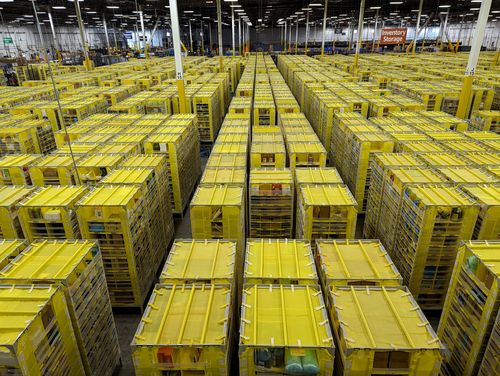If it’s hard to imagine what it feels like to give $1 million to charity and then get criticised for it, just ask billionaire Jeff Bezos.
At the time, Bezos’ net worth was estimated at $US116 billion.

Over the past three years, Amazon has opened six disaster relief hubs around the country – two in Melbourne and facilities in Sydney, Brisbane, Adelaide and Perth.
Stocked inside the hubs are 220,000 items – donated by Amazon – ready to be whipped out to emergency zones.
Amazon has long used machine learning, and more recently AI, to anticipate and source what customers want to buy online, and they’re applying the same tech to disaster relief.
The computer algorithms, paired with on-the-ground experience, helped Amazon work out what things people need most in the crucial first days of an emergency, or when they are suddenly been made homeless.
The packs, put together by Amazon volunteers, include toiletries, first aid kits, tents, tarpaulins, sleeping bags, kids’ colouring books, water and other items.
As workers brace for an extreme bushfire season this summer, the hubs have bustled with activity the past few months.
Charlotte Richardson, who leads Amazon’s disaster relief efforts in Australia, said Amazon has learned lessons from the Black Summer fires and assisting nonprofit charities and partners in more than 115 disasters here and around the world.
”We sort of quickly realised that the best way for us to be able to leverage our business was through the establishment of a disaster relief hub where we could work with our vendors and suppliers,” Richardson said.
“The feedback that we’ve had from our nonprofit (partners) is that storage and transport and procurement of relief items is really essential and something they genuinely need a lot of help with.”
Read Related Also: Boy, 10, dies after becoming trapped under lift at Sydney school
Since launching the hubs in Australia, Amazon has sent out more than 550,000 items in 14 disasters, including bushfires, floods and COVID outbreaks.

Abe Diaz, the head of Amazon’s global disaster relief program, said the mission is to bring Amazon’s delivery efficiency to disaster zones.
“For our relief partners, we are the one-stop shop that enables them to support and serve people quickly and more efficiently,” he said, when 9news.com.au recently toured Amazon’s headquarters in the US.
Trying to source products after a disaster had struck was too slow and didn’t make sense, he said.
Instead, Diaz said, Amazon’s power and scale allows it to get items close to disaster zones before they are needed, and store them in a way charities and non-profits can’t.
“That financial commitment (of storage) can be too much for them to handle,” Diaz said.
“Amazon is able to use our scale and existing networks to shoulder these loads.”

Diaz said delivering what disaster victims and charities actually need is crucial, and helps avoid what disaster relief groups call “the second disaster”, when a flood of unwanted donated goods is sent to the frontlines.
“Our flexible logistics allows us to quickly source and ship supplies that would otherwise be difficult to acquire locally,” Diaz said, “things like can openers, because when you have lost everything, what good is canned food if you can’t open it?”
Since the program began in 2017, Amazon said it has donated 23 million items in more than 115 disasters including bushfires, floods, hurricanes and landslides.
The reporter travelled to Seattle for the ‘Delivering the Future’ media event as a guest of Amazon. Amazon did not pay for this content.






